Lenses
ALL ABOUT OUR LENS TYPES AND TREATMENTS
These Lens Options Can Greatly Improve the Functionality and Cosmetic Appeal of Your New Glasses
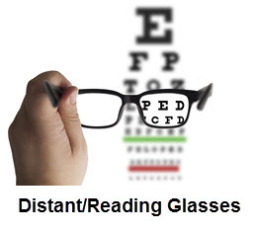
Single Vision Lenses
Single vision lenses are designed for the majority of eyeglass wearers. Most people who wear eyeglasses before the age of 40 require single vision lenses. Single vision lenses are used for near or far vision and also for reading glasses
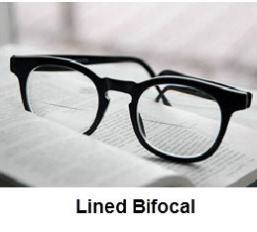
Lined Bifocal Lenses
Bifocals have visible lines in the lenses separating the viewing areas for distance and reading. The upper part is used for distance vision and the lower part used for near vision -- such as close reading.
Lined bifocals are usually prescribed for people over the age of 40. Whether you will need this type of lens depends on how often you will use your eyewear for both distance and reading correction (see the sample prescription below).
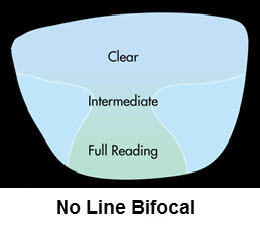
No-Line Bifocal Lenses
Progressive lenses (also called no-line bifocals) offer a smooth transition from distance vision through intermediate vision to near vision, and they supply all the in-between corrections as well. This means that instead of having just two different viewing zones (near and distant), like with lined bifocals, progressive lenses have progressively changing powers of correction (from bottom to top), easing eye strain and providing the most natural vision correction.
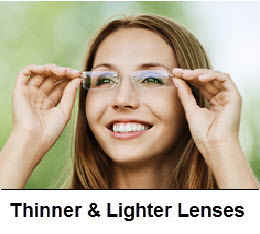
Thinner & Lighter Lenses
We recommend this lens option if you want thinner, lighter lenses and eyeglasses that are as attractive and as comfortable as possible. Thinner, lighter high-index lenses are especially recommended if you have a strong eyeglass prescription for nearsightedness, farsightedness or astigmatism. Most eyeglass wearers are nearsighted, which means the lenses will be thin in the center but thicker at the edge of the lens. The stronger the prescription, the thicker the edges.
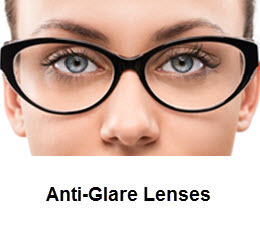
Anti-Glare Lenses
Anti-glare coating (also called "AR coating" or "anti-reflective
coating") improves vision, reduces eye strain and makes your overall
eyeglasses look more attractive.
These benefits are due to the ability of anti-glare coating to virtually
eliminate reflections from the front and back surfaces of your eyeglass
lenses. With reflections gone, more light passes through your lenses to
optimize vision with fewer distractions (especially at night), and the
lenses look nearly invisible — which enhances your appearance.
Anti-glare lens treatment is especially beneficial when used on
high-index lenses, which reflect more light than regular plastic lenses.
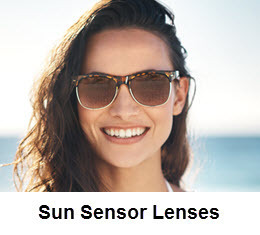
Sun Sensor Lenses
Sun Reactive Lenses (also referred to as Photochromic lenses) are eyeglass lenses that are clear (or nearly clear) indoors and darken automatically when exposed to sunlight. How do these lenses change color (or darkness)? - The molecules in the lens darken when they are activated by the sun's ultraviolet radiation. Because UV rays penetrate clouds, Sun Reactive lenses will darken on overcast days as well as sunny days. Sun Reactive lenses typically will not darken inside a car because the windshield glass blocks most UV rays.
Scratch Resistant Coating
Scratch-resistant treatments (also known as "hard coat") are applied to the front and back surfaces of lenses to protect against accidental scratching and to improve durability. Some high-quality lenses come from the factory with scratch treatments already applied. No treatment can make lenses completely scratch proof.
UV Lens Treatment
Ultraviolet protective lenses protect the eyes from ultraviolet sun rays that have been shown to cause cataracts and certain diseases of the eye. If you spend time outdoors or use a computer screen a lot, it is a good idea to have your lenses anti-UV treated.
Cumulative damage from prolonged exposure to sunlight causes 3.2 million people to go blind every year. That's why eyecare professionals always recommend protecting your eyes from UV rays any time you go outside. Our clear, protective lens coating blocks harmful UVA and UVB rays to help protect against; cancer and premature aging of the skin around your eyes and eyelids, damage to your cornea, lens, and other parts of your eye that can cause vision problems, and development of certain types of cataracts A little protection now will help you see long into the future.
Case and Cleaning Cloth
Each pair of glasses comes with an eyeglass case specially designed to protect your investment and a cleaning cloth that will help protect the lenses.
|






